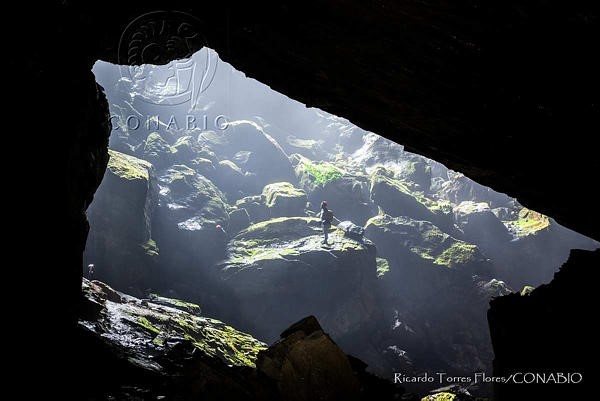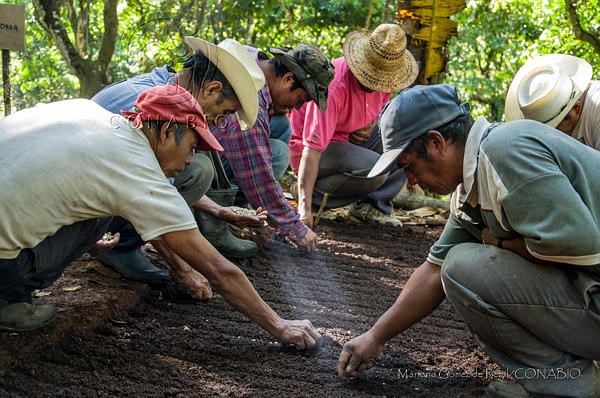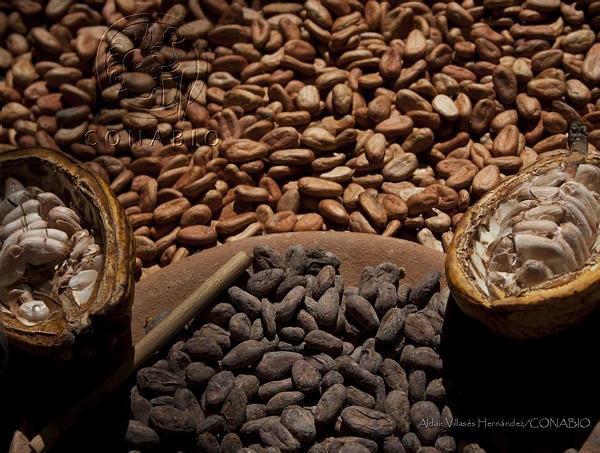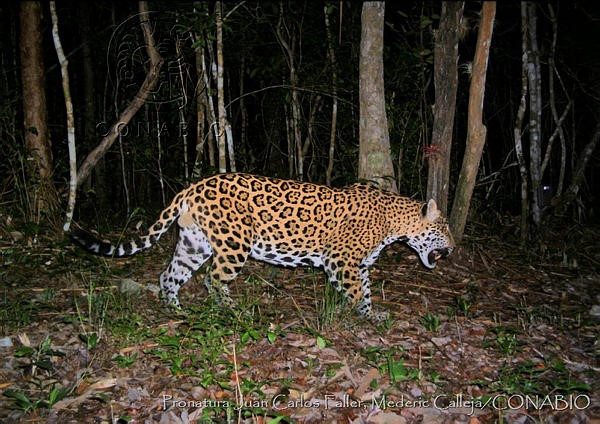Summary
Coordinated work for biodiversity conservation and environmental sustainability with the World Bank, the Global Environment Fund, and the Mexican government started in 1996, specifically targeting the Mesoamerican Biological Corridor. In that context, a new initiative was developed to promote mainstreaming biodiversity conservation with productive landscapes between 2012 and 2017. The specific objective of the project development was to conserve and protect nationally and globally significant biodiversity in Mexico through mainstreaming biodiversity friendly management practices in productive landscapes in priority biological corridors. This project implied a shift from original conservationist perspectives about the environment towards a view of productive and sustainable use of natural resources with a particular emphasis on the biological corridor region.

Sustainable use of the landscape.
Credit: Ricardo Torres Flores CONABIO.
A Preoccupying Context3
The Global Assessment Report on Biodiversity and Ecosystem Services released in May by The Intergovernmental Science-Policy Platform on Biodiversity and Ecosystem Services (IPBES) warns that “Nature is declining globally at rates unprecedented in human history and the rate of species extinctions is accelerating, with grave impacts on people around the world…”. It also states that around one million animal and plant species (half of all total living species) are now threatened with extinction and that more than three-fourths of the land surface and two-thirds of the ocean surface have been deeply affected by human activities, especially due to five direct drivers: 1) changes in land and sea use; (2) direct exploitation of organisms; (3) climate change; (4) pollution, and (5) invasive alien species.
Despite the situation, Robert Watson, IPBES’ Director for Strategic Development insists on the fact that "it is not too late to make a difference, but only if we start now at every level from local to global…through ‘transformative change4, nature can still be conserved, restored, and used sustainably.” He also explains that “transformative change” refers to a “fundamental, system-wide reorganization across technological, economic, and social factors, including paradigms, goals, and values"5. Thus, this showcases the relevance of a project which has recently finished in Mexico, called Sustainable Productive Systems and Biodiversity (SPSB)6 which will be discussed in this text.
Several elements may help address the relevance of this particular case:
- Mexico is recognized globally as a mega diverse country as it hosts around 12 percent of the world’s biodiversity in a territory of around 1.5 percent of the planet’s surface according to the National Commission for the Knowledge and Use of Biodiversity7 (CONABIO)8. Many are endemic species.
- Given that more than 50 percent of land use in Mexico is destined for agriculture and livestock production, adequate management and preservation of natural resources is inevitably linked to food production and income generation.
- Additionally, a permanent realignment of programs, policies, and institutions throughout all sectors has deeply affected incentives for sustainable use of natural resources and curbed market access to the poorest communities.
Given all these elements, it is relatively easy to understand the existence of underlying causes of natural capital degradation which contribute to what the IPBES report mentions as “deterioration of land and sea.”
Productive activities’ impact on biodiversity and the global environment may be observed through changes in land use: forest areas turned into agricultural use (including sun-grown coffee and cacao), grazing areas, or even forest plantations. Habitat destruction, soil erosion, water contamination, ecosystem fragmentation, and the loss of species result from these changes in land use. At the same time, given that most producers (and communities) live in poverty and deprivation conditions, their management decisions are strongly determined by short-term economic needs (usually through relative prices of different products) and therefore tend to outweigh long-term sustainability and environmental challenges.9 SPSB, which started in 2013, is a perfect match to what several years down the road will be called a global scale solution according to IPBES.

Oak pine forest in Oaxaca.
Credit: Saira Aylin Vásquez Vargas CONABIO
SPSB: The Project’s Background
Coordinated work for biodiversity conservation and environmental sustainability with the World Bank, the Global Environment Fund, and the Mexican government started in 1996, specifically targeting the Mesoamerican Biological Corridor. In that context, a new initiative was developed to promote mainstreaming biodiversity conservation with productive landscapes between 2012 and 2017. This effort was coordinated by the CONABIO.
This project implied a shift from original conservationist perspectives about the environment towards a view of productive and sustainable use of natural resources with a particular emphasis on the biological corridor region.
Another relevant issue was the recognition that SPSB influence areas have, besides a very significant share of the biological richness of the country, some of the most severe manifestations of poverty. This is why the project aimed to identify alternative income-generating opportunities through the incorporation of biodiversity-friendly practices, particularly in productive landscapes. The objective was set at 34,500 hectares of biodiversity conservation with high levels of sustainable production. To accomplish this, it became necessary to overcome the most usual setbacks:
- Low returns compared to conventional production;
- Lack of scale economies due to the atomization of production and commercialization;
- Inconsistency of organized productive efforts; and more importantly
- Scarce technical, administrative, and financial capabilities to adequately manage a change such as was intended, so that introducing biodiversity-friendly practices would effectively result in the reach of differentiated markets.
The specific objective of the project development was to conserve and protect nationally and globally significant biodiversity in Mexico through mainstreaming biodiversity friendly management practices in productive landscapes in priority biological corridors. Organizational efforts of producers incorporating sustainable use of biodiversity to enter new markets that could value these practices were recognized and promoted with the project. A key element to consider in this process was a strong support towards capability formation to manage biodiversity-friendly practices and enter new markets. In a broader approach to the project, it would also contribute to South-South cooperation, mostly with countries of the Mesoamerican Biological Corridor.
Originally, around 7,000 producers from six Mexican states (Yucatán, Quintana Roo, Campeche, Oaxaca, Tabasco, and Chiapas) would be reached in five years, linking profits to less environmental deterioration through smallholding sustainable production. Overall, 34,500 hectares managed with biodiversity-friendly practices would be attained, and at least 12 percent of the income from goods and products would be achieved through these practices.
Three Core Elements
In order to achieve the objectives, three types of activities were proposed:
- Incorporation of sustainable production and biodiversity maintenance in productive systems within the biological corridors.
- Strengthening of the producer associations capacity to expand business opportunities for biodiversity-friendly products coming from the project’s influence area; and,
- Improving the institutional framework to support sustainable productive system adoption as well as associated market tools including regional exchange programs between countries from the Mesoamerican Biological Corridor and other surrounding countries10.
Productive systems included silvo-pastoral, coffee production, cocoa and honey production, wildlife use and eco-tourism, and forestry. All were found in the productive landscape of the region both in the Mexican part of the corridor and in other neighboring areas. All grouped a significant number of producers, many of which have consolidated organizational experiences and use a considerable surface of land.
Innovative Nature
Having been close to the project since its origin allows me to affirm that there is no other precedent in Mexican public management due to its experimental and innovative nature which was assumed from its original design. Despite having set goals, this project engaged with deep learning about actions that could be designed, tested, and if successful, eventually translated into public policies.11 The fact that instrumentation was achieved through CONABIO was also quite outstanding given that this institution has built a reputation on scientific capabilities -- knowledge and use of biodiversity -- which allow it to be relatively isolated form traditional arrangements involving government offices highly driven by other interests and linkages that every day public management may generate. From this entity, a specific kind of experimental laboratory was organized to explore a different type of intervention in daily productive practices of regions with agricultural and livestock activities in south Mexico which could be engaged with environmental sustainability.
From its initial design, the project looked to build on the integration of different components by recognizing that traditional public programs tend to grant scarce, unarticulated, and discontinuous support to these types of initiatives. Therefore, any attempt to provoke ambitious changes as those mentioned above should start by compensating this condition. Exploring the diversity of its components may give an adequate idea of how an integrated vision was taken forward.
- The first component was oriented to promote sustainable productive systems and mainstream biodiversity. Technical assistance and capacity building for productive practices was offered to producer associations, through specialized technical services providers.
- Another relevant element consisted of strengthening the capacities of producer associations managing biodiversity-friendly production and marketing systems and improving associations’ collaboration capacity with other economic agents of the value chain for biolabeling products.
- Institutions, biolabels, and south-south cooperation component would develop institutional capabilities, design, and use of differentiation instruments for market products, commercial alliances, cooperation, as well as management and follow-up of the project. This last component would allow that SPSB could also have elements that implement administrative, planning, coordinating, biological monitoring, result monitoring, and evaluation functions.
Relevant Intervention Features
SPSB financing was also innovative given that it was integrated via counterpart contributions to a trust which concentrated the Mexican government contributions with international and private donations12, avoiding typical public programs’ uncertainty with multiannual commitments as the project required. Despite the effort, it was still not possible to operate with the sufficiency and opportunity required, but this type of financing surely constitutes a key characteristic for this type of proposals. Identification and offering of additional credit options to producer associations also resulted from the project even if most of the participants only used it partially.
In a similar manner, producer organizations’ activities were financed through contributions requiring counterpart investments together with a permanent participation articulated using business plans for production, processing and commercialization of biodiversity-friendly products which were specifically elaborated with and for each participant organization. Having a mid-term work plan was surely another trait in a context where annual uncertain budgets tend to be the usual.
According to data from public reports13, the project incorporated organizations with more than 13,000 producers in more than 81,000 thousand hectares, who managed to sell biodiversity-friendly products at twice their original estimates. While the final evaluation of the project is not yet released, original goals were most likely overachieved.
Participant organizations included eight specialized in forestry activities, six dedicated to coffee production activities, five working in honey production, four in ecotourism, two in cocoa production, and one in silvo-pastoral. From these organizations, the one dedicated to wildlife fauna sustainable use abandoned the project early and two could not complete the entire process.

Selecting coffee beans.
Credit: Mariana Gómez de Regil CONABIO
Other significant elements that show the innovative scope of this project are available along the variety of public reports including the following: the formalization of associations which began as informal groups of producers, which meant a substantial step forward in the capacity to collectively manage individual initiatives from their members; these associations were the fundamental actors in the formulation and instrumentation of their operative programs, acquisition and contract plans, as well as the implementation of the biodiversity-friendly plans which had environmental and social safeguards incorporated; all meant a great leap towards a new vision, a better exercise of budget resources, and a new set of managerial and administrative skills.
Available information such as the environmental safeguard reports, show how the biodiversity-friendly concept was positioned into productive practices, as does the fact that practically all producers were trained in such AB practices that were meant to be applied and incorporated to their productive processes. Learning practices went far beyond familiarization with the topics, the terms and the different techniques that could be applicable to every productive system -- some of which had already been applied by certain producers who were dedicated to organic production -- and show appropriation and commitment towards taking care of the environment while respecting, preserving, and sustainably using biodiversity.
Sustained specialized technical were accompanying14 throughout the entire process, another unusual trait of the traditional Mexican administrative practice, was highly valued by producers in the elaboration, implementation, and follow-up of their business plans because it allowed for knowledge and experience expansion in a variety of topics related to production, biodiversity-friendly practices, administrative, and management skills. The possibility of documenting traceability of processes along all producer activities which have already been useful in certain cases to obtain honey and coffee certifications and to show which evidences are helpful to access special markets that are willing to pay specific preferential prices to producers given that they can demonstrate biodiversity-friendly productive systems (mostly coffee and cacao).

Cocoa Seeds.
Credit: Aldair Villaseñor Hernández, CONABIO
On the one hand, highly specialized support through technological transference units was also available for producers. In some cases, units were the national representations of productive activities as in the case of coffee, and in others, such as honey and cacao production, academic institutions were incorporated for the task. In the case of forestry and ecotourism activities, recognized civil society organizations participated. This permitted some associations to abide with necessary requirements to access specialized products certifications with that specific difference and also allowing the search of markets for those particular products.
On the other hand, exchanging experiences and getting acquainted with other production and commercialization value chains by participating in trade fairs and international business tables opened up a variety of perspectives and different roads towards certain identified markets.
A standard definition for each of the selected productive systems in order to credit biodiversity-friendly practices was put in place by Conabio based on its own expert knowledge together with a certification entity. This was also an important milestone to eventually institutionalize these types of practices. Other consultancies facilitated the dissemination and outreach of knowledge of what was established in safeguards to protect biodiversity. Consequently, a photograph and video collection with biodiversity-friendly production processes as well as species conservation impacts resulting from those practices in productive landscapes exist.
Some Identified Achievements
Effects of the intervention have permeated in some communities until today: an interest to protect biodiversity, a project’s appropriation, and life quality repercussions are still present. Women have incorporated into productive system processes and young persons are ever more interested in biodiversity monitoring.
Lessons and Caveats
Obstacles and challenges present throughout the entire implementation of the project have probably limited its impact on the broader objectives. Operators’ and producer organizations’ learning processes took longer than expected, scarcity and lack of opportunity of financial resources were also present due to political and administrative inertias, as well as common barriers to innovative initiatives. A topic which was not thoroughly attained was the governmental institutionalization of learnings because the project took place in a time frame with two political administrative changes. The project was promoted and approved within a particular political context, then implemented during a different political context, and now that it is over, it is currently being assessed with a yet different political background than the previous two administrations. This situation has unavoidably affected the environment in which the project has developed, and augments the challenging implications deriving from an approach that parts from the traditionally segmented policy initiatives which lack the inherent complexity.

The jaguar is emblematic of the Pronatura Project area.
Credit: Juan Carlos Fuller, Mederic Calleja, CONABIO.
A Final Consideration
The experience hereby detailed is a case of social innovation which may share some of what has been known and explored in different contexts as public policy laboratories because a combination of instruments and mechanisms have been put in place to identify and truly solve some problems instead of only administrating them.
Adopting biodiversity-friendly practices in small and poor producers’ daily activities meant placing persons and natural capital in the center of the entire proposition, thereby transcending the linear and fragmented silo logic of the Mexican public management. This also meant going against the general trend of transferring insufficient and regressive cash from the perspective of the natural resources. The proposal was to instead incorporate sustainable productive practices that could arguably add value in adequate markets.
Biodiversity mainstreaming and financial concurrence with a multiannual character helped emphasize the allocation and strengthening of producer capabilities with a significant effect on their families and communities.
The counterparty model favored financial concurrence and also attempted an institutional change in the two current offices which are responsible in Mexico for production and biodiversity protection, the Secretary of Agriculture, Rural Development, Fisheries, and Food (SAGARPA)15 and the Secretary of Environment and Natural Resources (SEMARNAT) in a process that would bring environmental sustainability in a multisector topic that can pave the road towards new policy design.
Concurrent financing between donators’ resources and federal programs targeted towards linking national and global markets, with a particular focus on specialized markets gave the model more viability, sustainability, and competitiveness to productive chains and production systems.
Associating natural capital sustainable use with productive practices and their market expression constituted a milestone in environmental policy approaches, as in the direct operation with organized producers to potentiate their modest actives through associative efforts.
Main success drivers that should be assessed include simultaneously addressing environmental and biodiversity issues together with productive market access challenges, individual and collective development, and strengthening of organizational capabilities together with productive, marketing, monitoring, and understanding of biodiversity.
Offering organized producers the permanent specialized knowledge tailor-made for different moments of productive processes was also a significant aspect. And articulating a business plan designed with the producers themselves made a relevant case for participants’ bottom-up visions, contributions, activities, and capabilities which certainly incentivized their commitment with the project.
Participatory mechanisms such as public consultation within the producer groups integrating the associations and with other key stakeholders at every specific influence territory promoted their participation and facilitated the verification of biodiversity-friendly practices and the use of social and environmental safeguards.
As available inputs confirm, it is possible to associate biodiversity friendly practices with intervention consequences, which have created evidence for dissemination and have allowed monetization when reaching differentiated markets.
Standard establishment adopted by producers and verified by third parties, either through bioseals, certifications, or some other instrument that may help guarantee consumers that certain goods or services have been produced in biodiversity-friendly environments, efficiently generated appropriate conditions in market niches susceptible of appreciating this differentiation element. Additionally, project results opened up the space for an effective financial inclusion with an identification -- even from the embryo if needed -- of those particular financial agents upon which it is possible to rely on for cases where the projects flux made it possible.
Management capabilities development of business and development alliances as well as credit access alternatives constitute a set of elements that defined the Project and credit its innovative character.
To conclude, the somber landscape presented by the IPBES report referred to at the beginning of this text also suggests some elements to tackle the problem and proposes to approach political incoherence with an integrative governance; to take decisions based on legitimate and credible knowledge for an informed governance; to allow learning towards and adaptative governance; and to guarantee equity and participation to an inclusive governance.
Based on what has been previously described, the SPSB experience points precisely to that direction, and similarly, it could be assessed as an experience with many characteristics of a transformative change such as is required today. In the words of Sandra Díaz, copresident of the PBES evaluation, “the contributions from biodiversity and nature are our own asset value, as well as the most important security net for the life of humanity.”
Author bio

Pablo Agustín Fregoso Rojas2 is an economist with extensive experience in the public sector with a long career in the public sector in several fields like social development, treasury and public finance, and environment where his scope of work was focused on finding solutions to overcome extreme poverty, regional development, and public management. Ha has led several conferences in social economy, promoting incubation of projects in the social field of economy and as a private counselor for federal and local entities and social rural organizations in Mexico. At present, he works in issues related to social innovation, family agriculture, and environment.
Notes
1 Special thanks to Francisco Abardía Moros, leader of this initiative, for the generosity to allow me a close follow-up of the process and a permament participation on the project's development and assessment.
2 General Director of Consultores Especializados y Soluciones Integrales (CESOI, S.C.)
3 I thank Paulina Terrazas for the translation of this article
4 Currently, an effort in that direction is being led by the Transformative Innovation Policy Consortium (TIPC), a group of policy makers and financing agencies in which Colombia, Finland, Mexico, Norway, SouthAfrica and Sweden participate, coordinated by the Science and Policy Research Unit at the University of Sussex in the United Kingdom. They work to put forward a new framework for Science, Tecnology and Innovation Policy (STI) aiming to contribute to tackle global social challenges as those promoted by the Sustainable Development Goals including climate change, inequality, employment and roads to economic growth and development. www.tipconsortium.net/about/
5 These references come from IPBES Press Release available on the following link: www.ipbes.net/news/.
6 projects.worldbank.org/P121116/ www.biodiversidad.gob.mx/corredor/SPSB/
7 CONABIO is an intersecretarial commission with the mission to promote, coordinate, support and develop activities to increase knowledge of biological diversity, its preservation and sustainable use for the benefit of society.
8 CONABIO. 2006. “Capital natural y bienestar social”. Comisión Nacional para el Conocimiento y Uso de la Biodiversidad, México.
9 documents.worldbank.org/curated/en/.pdf
10 These features are available on page 8 and 9 of the document entitled “PROJECT APPRAISAL DOCUMENT ON A PROPOSED GRANT…” en: documents.worldbank.org/curated/en/
11 Practically all information that backs up what is expressed in this article may be found in different documents and reports available on the World Bank website: projects.worldbank.org/P121116/
12 Support from Fomento Social Citi Banamex was very important to develop this initiative.
13 World Bank final reports.
14 This was accomplished through the work of local working groups or specialized offices who were to have local presence and experience and were selected among producer associations and CONABIO.
15 Esta dependencia ha cambiado recientemente de nombre y hoy es la Secretaría de Desarrollo Rural (SADER)
Works Cited
AD, NAFIN-BIRF. (03 de Octubre de 2012). Acuerdo de Donación del Fondo para el Medio Ambiente Mundial. Recuperado el 15 de Octubre de 2018, de documents.worldbank.org/curated/
Ayuda de Memoria 0, Banco Mundial. (2013). Misión de Lanzamiento realizada del 20 al 25 mayo de2013. Ayuda de Memoria. Recuperado el 15 de noviembre de 2018
Ayuda de Memoria 10. Banco Mundial. (2018). Misión de Apoyo a la implementación del 23 al 26 de abril de 2018. Recuperado el 20 de noviembre de 2018
Ayuda de Memoria 3, Banco Mundial. (2014). Informe de Misión Técnica del Proyecto Sistemas Productivos Sostenibles y Biodiversidad del 1 al 6 de septiembre de 2014. Recuperado el 12 de noviembre de 2018
Ayuda de Memoria 5, Banco Mundial. (2015). Informe de Misión de Medio Término realizada del 27 de septiembre al 2 de octubre de 2015. Ayuda de Memoria. Recuperado el 13 de noviembre de 2018
Ayuda de Memoria 7, Banco Mundial. (2016). Misión de Supervisión realizada de septiembre a noviembre de 2016. Ayuda de Memoria. Recuperado el 18 de noviembre de 2018
Ayuda de Memoria 9, Banco Mundial. (2017). Misión de Apoyo a la implementación realizada en julio de 2017. Ayuda de Memoria. documentos.bancomundial.org/curated/
Banco Mundial. (Varios años). Informes sobre el estado de ejecución y resultados. projects.bancomundial.org/P121116/
Banco Mundial, Políticas ambientales y sociales para proyectos. (s.f.). Banco Mundial. www.bancomundial.org/es/projectsoperations/
ENB, SEMARNAT-CONABIO. (2000). Estrategia nacional sobre biodiversidad en México. www.conabio.gob.mx/conocimiento/
PAD, Banco Mundial. (06 de agosto de 2012). Documento de Evaluación Incial del Proyecto Sistemas Productivos Sostenibles y Biodiversidad. documents.worldbank.org/curated/
Valdez, M. d. (2012). Informe de Evaluación Ambiental del Proyecto: Sistemas Productivos Sostenibles y Biodiversidad. Obtenido de documents.worldbank.org/curated/


